Fossil palm wood or Palmoxylon
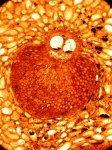 In some regions of the Netherlands a lot of petrified wood has
been found which is called palm wood or Palmoxylon. These are boulders
probably transported by rivers and/or ice from Germany. In several states
in the Unites States so much petrified palm wood is found that is has got
a place of honour: it has become a State Fossil. In some regions of the Netherlands a lot of petrified wood has
been found which is called palm wood or Palmoxylon. These are boulders
probably transported by rivers and/or ice from Germany. In several states
in the Unites States so much petrified palm wood is found that is has got
a place of honour: it has become a State Fossil.
This fossil is not always really originating from palms, but in most cases
it is.
Below the structure of Palmoxylon is described on the basis of specimens
and transverse sections. Identification of species is not the subject of
these pages: this is a task for specialists. Besides there are a lot of
uncertainties in distinguishing species because the structures can be very
different dependent on the place in the trunk.
The palms appeared for the first time in the Senonian (Late Cretaceous)
and underwent their most important radiation probably in the Paleogene.
Characteristics
 Palm wood is characterized by the presence of a great nummer
of thin tubes, laying dispersed on a transverse section of the wood (click
on the photo on the right). On the sides of the wood the tubes are running
roughly parallel to the axis of the trunk. In the side view there are also
little holes visible, because the tubes are rather flexuous. The diameter
of all tubes is about the same. When there are thin as well as thick tubes,
you don´t have palm wood but e.g. Tempskya. Palm wood is characterized by the presence of a great nummer
of thin tubes, laying dispersed on a transverse section of the wood (click
on the photo on the right). On the sides of the wood the tubes are running
roughly parallel to the axis of the trunk. In the side view there are also
little holes visible, because the tubes are rather flexuous. The diameter
of all tubes is about the same. When there are thin as well as thick tubes,
you don´t have palm wood but e.g. Tempskya.
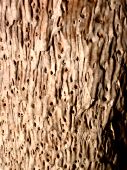
1. filled up tubes |
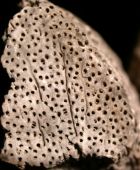
2. moon eclipse |
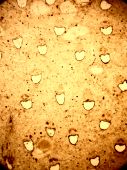
3. little moons |
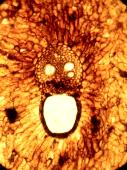
4. vascular bundle |
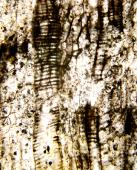
5. wood vessels |
Mostly the tubes are empty, but sometimes they are filled up, like in
photo 1 (click). Looking through a loupe one will see that the tubes are
not circular but that they have the shape of a moon during an eclipse (click
photo 2). A transverse section of such a piece of palm wood makes this still
clearer (click on photo 3). Microscopic slides from material from the Netherlands
show in nearly all cases a bad conservation of the internal structure. In
photo 3 for example all cell structure has vanished. There are, however,
exceptions in which the structure has been preserved very well in some places.
This is the case in photo 4. The large white spot has been filled up with
sclerenchyma cells, i.e. thickwalled cells providing stiffness. The three
small white spots are transverse sections of wood vessels. Click photo
4 for more details. The wood vessels are reinforced with annular
and spiral thickenings (click photo 5).
The structure of the vascular bundle
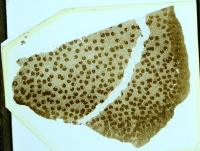  One
of the finest slides I know is the one which was bought in England by the
Groningen University in 1922. It has been manufactured from a piece of palm
wood probably originating from France (according to the comment). Click
on the photo on the left to have a close look at the slide. One
of the finest slides I know is the one which was bought in England by the
Groningen University in 1922. It has been manufactured from a piece of palm
wood probably originating from France (according to the comment). Click
on the photo on the left to have a close look at the slide.
Click on the photo on the right to look at one of the vascular
bundles and to get some explanation.
Besides the described vascular bundles there are also bundles which
only exist of sclerenchyma cells. The diameter of these sclerenchyma bundles
is very small compared to that of the vascular bundles. Their function is
to give more stiffness to the trunk. Click on photo 2 below and also on photo
1.
Some of the vascular bundles bend off in a horizontal
direction. This is shown for example in photo 3. These bundles are heading
for a leaf and are sometimes called crossing bundles because they cross the
other ones.
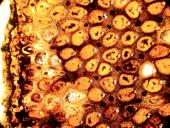
1. oriented bundles |
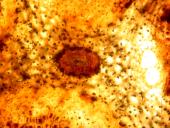
2. sclerenchyma bundle |
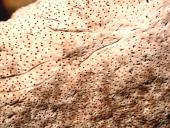
3. crossing bundles |
The bark
Only in rare cases the bark has been preserved
in fossil palm wood.
Photo 1 above shows a transverse section of a bark region. Clearly visible
is the fact that the vascular bundels are oriented in a certain direction:
they are lying with the sclerenchymatic cap in the direction of the bark.
Generally the orientation disappears as the distance to the bark
increases.
In the collection of Huis Bergh at 's Heerenbergh (NL) are a couple
of specimens with preserved bark. Click on photo 1 below for details. The
specimen of photo 2 is partly covered with bark and it shows three scars
of petioles (click).
Photo 3 shows a rather big specimen of palm wood, probably the top of
a trunk, with very large leaf scars (click).
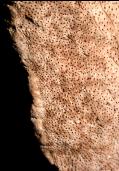
1. palm wood with bark |
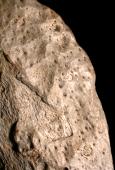
2. palm wood with bark |

3. leaf scars |
Wood or not?
In fact Palmoxylon does not conform to the definition of wood.
Wood in the narrow sense is secondary xylem, i.e. wood tissue formed by a
cambium. All deciduous trees (dicotyledons) do have such a cell layer, which
produces bark to the outside and wood to the inside. By far most of the
monocotyledons, under which the palms, do not possess a cambium.
Palms have developed their own way of forming trunks. This is roughly as
follows:
From the seed comes a young plant with rosette leaves, which is growing
in the horizontal plane during a long period (1 to 5 years). In this way
a firm base is formed from which later on the trunk can develop. After this
phase several growth zones develop causing both increase in thickness as
well as in height. In this way a trunk comes into existence completely consisting
of primary wood tissue. As a consequence the thickness of the stem will not
decrease while growing higher, like the stems of dicotyledon trees do, but
stay in principle equally thick, although the thickness can show variation
as a consequence of better or worse circumstances.
Because of indolence and usage I do yet speak of palm wood. It would
be better to write palm 'wood'.
Palm or not?
There are more monocotyledonous trees with a trunk structure like the
palms. Examples are Dracaena, Yucca and Pandanus.
Specialists are able to distinguish the fossils of the different groups.
It is generally assumed that most of the Palmoxylon specimens are
originating from real palms.
Preservation
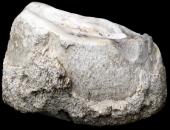 Palmoxylon
fossils from the Unites States are often preserved much better than those
in Holland. In Indonesia too palm wood of very good quality is found (click
on the photo on the left). Palmoxylon
fossils from the Unites States are often preserved much better than those
in Holland. In Indonesia too palm wood of very good quality is found (click
on the photo on the left).
Obviously the Dutch palm wood has been fossilized under much worse
conditions. Probably there was less silica dissolved in the water and/or
there was less abundant water. Therefore the process of silification was
going much slower.
Two factors were playing a role in the process of silification. First
the permeability of the cell walls for the siliceous water, secondly the
speed of the decaying process of the cell walls. The thinwalled parenchyma
cells (the ground tissue) were decomposing very quickly, but they were also
drenched very soon. The extremely thickwalled sclerenchyma cells decayed
very slowly, but were nearly impermeable to water. The wood vessels and tracheids
were rather thinwalled and easily penetrated by water, and besides they were
resistant to decay because of the strong annular and spiral
thickenings.
So the empty tubes in the Dutch palm wood are a consequence of the fact
that the thickwalled sclerenchyma cells had been decayed before the silica
water had penetrated the cells.
Roots
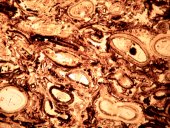 Palm
trees have a lot of roots underground. On the lower part of the trunk often
aerial or adventitious roots are found. These are partly embedded in the
bark. They can be seen very nicely on the photo of the palm basis above (click).
Sometimes silicified wood of palm roots is found. For identification you
need a transverse section and an expert. Click on the photo on the right
to see a microphoto of such a piece of palmroot wood, called
Rhizopalmoxylon. Palm
trees have a lot of roots underground. On the lower part of the trunk often
aerial or adventitious roots are found. These are partly embedded in the
bark. They can be seen very nicely on the photo of the palm basis above (click).
Sometimes silicified wood of palm roots is found. For identification you
need a transverse section and an expert. Click on the photo on the right
to see a microphoto of such a piece of palmroot wood, called
Rhizopalmoxylon.
It is amazing how few papers have been written on the subject of
Palmoxylon. The standard work is the 300 pages article "Fossile
Palmenhölzer" by Stenzel from 1904 (!). It is in German. Furthermore
I have found some other publications in German and in Dutch, but that was
all. An important reason is probably that there are many uncertainties and
traps in trying to identify species of Palmoxylon. But it seems that
here is a vast unexplored field waiting for ambitious people.
Literature
Top |